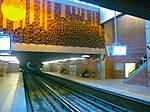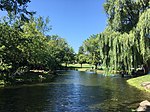Institut de pastorale des Dominicains
Buildings and structures in MontrealCanada university stubsCatholicism in CanadaChristian education in CanadaEducation in Montreal ... and 3 more
Montreal stubsSeminaries and theological colleges in CanadaSeminary stubs
Institut de pastorale des Dominicains is the Montreal, Quebec branch of the Dominican University College / Collège Universitaire Dominicain, a Roman Catholic university based in Ottawa, Ontario. The institute offers, in French, programs in pastoral or liturgical theology or in catechism, leading to university certificates and bachelor's degrees.
Excerpt from the Wikipedia article Institut de pastorale des Dominicains (License: CC BY-SA 3.0, Authors).Institut de pastorale des Dominicains
Chemin de la Côte-Sainte-Catherine, Montreal Côte-des-Neiges–Notre-Dame-de-Grâce
Geographical coordinates (GPS) Address Nearby Places Show on map
Geographical coordinates (GPS)
| Latitude | Longitude |
|---|---|
| N 45.506388888889 ° | E -73.621111111111 ° |
Address
Communauté Chrétienne Saint-Albert-le-Grand
Chemin de la Côte-Sainte-Catherine 2715
H3T 1B6 Montreal, Côte-des-Neiges–Notre-Dame-de-Grâce
Quebec, Canada
Open on Google Maps






